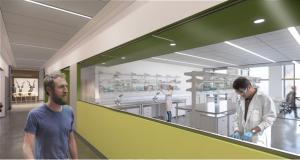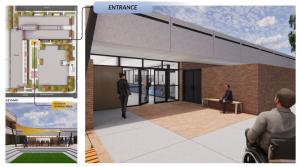Beach Launch Pad Gains Steam

The College of Engineering's efforts to complete a comprehensive renovation project, known as the Beach Launch Pad, is gaining steam, needing only $6 million more to complete the project as imagined.
According to Long Beach Mayor Rex Richardson, over the next two years, Long Beach can anticipate more than 1,000 new high paying engineering, tech and advanced manufacturing jobs.
Answering the call, the Beach Launch Pad improvements are designed to launch students into the future and directly into the career field, ensuring they are day-one ready by providing cutting-edge equipment and project spaces.
"These renovations will build capacity for project-based learning, furthering our learn-by-doing philosophy," said Dean Jinny Rhee. "The new facilities will strengthen our capabilities and will facilitate the college's work on multidisciplinary grand challenges."
Renovations will primarily be focused in the Beach Launch Pad, located in the ET-Wing. It will house updated equipment in the machine shop, a new rocket lab, and an additive manufacturing lab. To keep up with the growing needs of the Aerospace Industry, the college plans to add a clean room— which is required for work on satellites. With drones also becoming ubiquitous, there are plans to install a drone cage. COE students are diverse and ambitious, their project spaces should be as well.
"The [Dean's Advisory Council] members keep us informed of the future directions of their industries," said Rhee. "For example, we learned through the DAC that 90% of the Space industry was satellites, and only 10% is Launch. This motivated us to pursue facilities that allow us to do satellite projects, which we currently do not have."


Thanks to support from the community, such as alums Hing and Doris Hung, Hing is the co-founder of Mercury Security Corporation, and Said Hilal, founder of Applied Medical, and other alumni donors, the college is only $6 million away from its goal for the project.
Hung, co-founder of Mercury Security Corporation, and his wife Doris are generous supporters of the College of Engineering. He has also supported the Anna W. Ngai Alumni Center and scholarships across campus. He is a recipient of the distinguished alumni award.
Hilal is the founder of Applied Medical. He serves on the 49er Foundation Board and the COE’s Dean's Advisory Council, and, together with his wife Linda Lamb '71, is a major supporter of the College of Engineering. In 2023, he was awarded an honorary PhD for his contributions to CSULB.
Both Mercury Security Corporation and Applied Medical have a long-standing tradition of bringing in Beach Graduates as interns and professionals. Applied Medical has hired over 175 CSULB alums, many of whom give back by mentoring, speaking on career panels, hosting tours of the company facilities, serving on advisory boards, and donating.
This strong connection not only benefits alumni, but drives continual investment in the university’s future— like the Beach Launch Pad. Aimed at modernizing infrastructure and enhancing the learning experience, these renovations are poised to redefine the educational landscape for both students and faculty members.
Central to the renovation plans is the establishment of shared multidisciplinary lab spaces. New chemical fume hoods and storage will be centrally located, making their use more efficient and safe. By adopting a shared research-lab model and repurposing underutilized areas, we aim to maximize usage and minimize idle spaces. Recognizing the importance of cooperation, these labs will serve as hubs for collaborative exploration and discovery. The aim is to cultivate a culture of cross-pollination and teamwork essential for tackling real-world challenges.

The courtyard outside of EN3-EN4 will also be receiving upgrades, including a new covered, lighted project bays. It will also see improvements to the surrounding pavement, fencing and infrastructure.
"One focus is modern, smart infrastructure to control and monitor the building environment to provide the climate needed for modern equipment," said Glen Seymour, College of Engineering Facilities Manager, "The new design is flexible to keep up with advances in technology and college needs. [Future] conversions can be done in a few weeks without major changes."
Generally, the current infrastructure, while functional, needs upgrading to keep pace with technological advancements. For instance, the HVAC system lacks compatibility with certain 3-D printing technologies, hindering innovation in areas such as additive manufacturing. Through strategic renovations, the college seeks to future-proof its spaces, ensuring they remain adaptable and conducive to cutting-edge research and experimentation.

As a symbol of this joint effort, the entryway and lobby will be dedicated to underscore our commitment to fostering a culture of philanthropy and collaboration. Naming opportunities are available for the wing overall as well as the labs and project spaces.
Fundraising efforts will be crucial to realizing this vision, with a construction timeline spanning 12-18 months. Looking ahead, discussions are underway for the inclusion of additional shared labs, such as materials characterization, microfabrication, and robotics hubs, further enriching the learning environment for generations to come.




